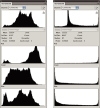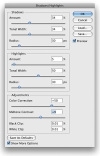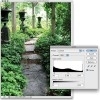Making Other Adjustments
Variations is a quick and intuitive way to adjust color, but sometimes it doesn’t give you enough control. Other times you just want to experiment. These are the times when you’ll want to work with individual adjustment settings.
Consulting the Histogram
Photoshop’s Histogram panel was once a dialog box; now it’s even easier to get to, and you can have it open on your screen all the time. As with the Info panel, the Histogram panel doesn’t actually do anything, but if you learn how to use it, you can really improve the quality of your pictures.
If you ever studied statistics, you already know that a histogram is a type of graph. In Photoshop, it’s a graph of the image that can show you the image’s brightness levels overall or broken down by color. The height of the graph indicates the number of pixels at each brightness level from 0 to 255.
You might wonder why this is important. Mainly, you can tell by looking at the histogram whether there’s enough contrast in the image to allow you to apply corrections successfully. If you’re working with a photo that looks pretty bad at first glance, studying the histogram will tell you whether it’s worth working on or whether you should trash the image and start fresh. If all the higher levels of the graph are bunched up at one end of the graph, and the image isn’t supposed to be very dark or very light, you probably can’t save the picture by adjusting it. On the other hand, if you have a reasonably well-spread-out histogram, there’s a wide enough range of values to suggest that the picture can be saved. Watch out for gaps in the middle of the graph and for ends that cut off suddenly instead of tapering gently down to 0. Figure 5.4 shows the histogram for a reasonably well-exposed photo alongside the graph of a problematic image.

Figure 5.4 Can you tell which picture is probably beyond help from looking at these histograms? Answer: It’s the one with the big spike in the middle of a flat graph.
Adjusting Levels
The Levels command gives you a method of adjusting the brightness of an image based on a version of the picture’s histogram (see Figure 5.5). Setting the black point (the slider at the left of the histogram that represents absolutely saturated black) to match the concentration of darkest levels in the image, and setting the white point (the slider on the right, indicating completely unsaturated white) to match the concentration of the lightest levels in the image forces the rest of the levels to spread out more evenly across the graph. If you want to experiment with the photo I’m using in these examples, it’s available on the book’s website; the file is called pathway.jpg.

Figure 5.5 Be sure to check the Preview box so that you can see the effect of your changes.
You can also use the Levels dialog’s special Eyedropper tools to adjust the levels. Click the white Eyedropper (on the right) and click the lightest part of your image. Then switch to the dark-tipped Eyedropper (on the left) and click the darkest point on the image. To adjust the midtones, you can use the gray midrange Eyedropper (in the middle) to locate an area in the image that should be right in the middle of the brightness spectrum. Avoid using the midrange Eyedropper in a color image—stick to grayscale images—unless it has an area that’s supposed to be a neutral gray—neither reddish (warm) nor bluish (cool); if you click in a colored area, Photoshop adjusts all the image’s colors so that the area you clicked in doesn’t have any color.
Adjusting Curves
Adjusting curves is much like adjusting levels, with a bit more control. You can use the Curves dialog box instead of the Levels dialog box to adjust the brightness. The big difference between using Levels and using Curves is that, with Curves, instead of adjusting at only three points (black, middle, and white), you can adjust at any point (see Figure 5.7).

Figure 5.7 On this kind of graph, the zero point is in the middle.
Despite the name, the Curves dialog box doesn’t display a curve when you first open it. Instead, you see a graph containing a grid overlaid with a diagonal line. The horizontal axis of the grid represents the original brightness values (input levels) of the image or selection, whereas the vertical axis represents the new brightness values (output levels). When you open the Curves dialog, the graph starts out as a straight diagonal line because no new values have been mapped; the input and output values are identical for all the pixels in the image. As always, be sure to check the Preview box before doing anything else so that you can see the effects of your changes in the image window.
As with the Levels dialog box, you can click Auto to have Photoshop make the adjustment for you, you can choose an option from the Preset pop-up menu, or you can use the Eyedroppers to adjust the values. Because the Curves method of adjusting brightness gives you so much more control, however, it’s worth making your changes manually. Click and drag over a portion of the image that needs adjusting. You’ll see a circle on the graph at the point representing the brightness level of the pixel under the cursor. If you don’t want to change certain points on the curve, click them now to lock them down. For instance, if you want to adjust the picture’s midtones while leaving its dark and light areas alone, click the light and dark points on the curve to fix them in place. Then click to add a point in the middle of the curve and drag up or down until the image looks right to you. Dragging up lightens tones, whereas dragging down darkens them (see Figure 5.8). To remove a point, click and drag it off the grid.

Figure 5.8 You can add up to 16 points on the curve.
In Photoshop CS4, Curves has a new feature: You can click the On-Canvas Adjustment button and then click and drag right in the picture to adjust the graph (see Figure 5.9). This way, when you click and drag in the image to locate the corresponding point on the graph, you can then go ahead and make the adjustment right there, without having to move your mouse over to the Curves dialog. One great application for this feature is fixing clipped areas: Click the Show Clipping box so that you can see where the clipped areas are; then click each area with the On-Canvas Adjustment tool and drag up or down to ameliorate the clipping.

Figure 5.9 To make on-canvas adjustments, click the button labeled with a finger icon, and then click and drag right in the picture. Here I’m working on the iron planter at the left edge of the image.
If you’re comfortable drawing freehand, you can also adjust the Curves graph by clicking the Pencil tool in the upper-left corner of the dialog and then clicking and dragging in the graph. This is an especially effective way to work if you’re using a graphics tablet and stylus instead of a mouse, trackball, or trackpad; as you’ve probably noticed, it’s quite difficult to draw neat curves with a mouse.
Click the disclosure triangle labeled Curve Display Options at the bottom of the Curves dialog to see a few choices you can make about how the graph is displayed. First, you can choose to display Light levels or Pigment/Ink levels; if dragging upward to darken the image and downward to lighten it makes more sense to you, then switch to the Pigment/Ink display. The four check boxes below enable you to hide or show channel overlays, the baseline (the graph’s original line), the histogram (the graph of brightness levels), and the intersection line (the vertical and horizontal lines that appear when you move a point on the graph).
Adjusting Color Balance
To really understand color balance, you have to look at the color wheel (see Figure 5.10).

Figure 5.10 If the color wheel were a clock, red would be at 3 o’clock and cyan would be at 9 o’clock.
If you follow the line from any color on the color wheel through the center and over to the other side of the wheel, you reach that color’s opposite. Cyan is opposite red, green is opposite magenta, and yellow is opposite blue. With the Color Balance dialog, you reduce one color by adding more of its opposite. Increasing cyan reduces red. Increasing red reduces cyan, and so on, around the wheel.
Color Balance is intended to be used to adjust color throughout an image, although, of course, you can use it with just part of the image selected (see Figure 5.11). For example, if you’re dealing with a picture that has an overall color cast, such as an old, yellowed photograph, Color Balance makes it simple to remove the yellow without altering the rest of the colors in picture. Just use a light touch, and make sure you check the entire image before clicking OK, in case your changes have actually introduced a new color cast.

Figure 5.11 Drag the sliders in the direction of the color you want to add to the picture.
As with the Variations command described earlier, Color Balance requires you to indicate whether you want to work on an image’s shadows, midtones, or highlights. And because color changes can affect an image’s overall brightness, Color Balance provides you with a Preserve Luminosity check box; turn this on to make sure that your changes affect only the hue component of each color in the image, leaving the brightness as is.
Adjusting Hue and Saturation
As you know, you can adjust the hue, saturation, and brightness of an individual color in the Color Picker. With the Hue/Saturation dialog, you can do the same to every color in the image (or in a selection) simultaneously. Don’t be misled by the fact that “Brightness” isn’t part of the command’s name; it’s included in the dialog nonetheless in the form of a Lightness slider.
First, look at the controls in the Hue/Saturation dialog box (see Figure 5.12). As with the Levels and Curves dialogs, Hue/Saturation offers you several prefab combinations of settings in the Preset pop-up menu. These make good starting points for your own adjustments. The second pop-up menu lets you choose either a single color to adjust or the Master option, which adjusts all the colors in the image or selection at the same time. For now, choose Master from the menu. Check Preview so that you’ll be able to monitor the effects of your changes in the image window.

Figure 5.12 Minor adjustments to lightness and saturation are usually all you need to make a major improvement in an image.
Now let’s take a look at the three sliders: Hue, Saturation, and Lightness:
- The Hue slider displays a flattened version of the color wheel. With Master selected, dragging the slider shifts all the image’s colors the corresponding distance around the wheel. Starting with red (in the middle of the slider), you can move all the way left—through purple to blue or blue-green—or right through orange to yellow and to green.
- The Saturation slider starts out at 0%, in the center, and you can drag it right to 100% saturated (pure color, with no gray), or left to –100%, or completely unsaturated (no color).
- The Lightness slider lets you increase or decrease the image’s brightness, from 0 in the center to +100 on the right or –100 on the left.
As you move each of the sliders, watch the two spectrum bars at the bottom of the dialog, as well as the image itself. The upper bar represents the current status of the image, and the lower one shows how each color in the image changes according to the slider(s) you move. If you drag the Hue slider to +60, for example, you can see by comparing the two spectrum bars that the reds in the picture will turn quite yellow and the blues will turn purple. In effect, you are skewing the entire color spectrum by 60°. If you move the Saturation slider to the left, you’ll see the lower spectrum bar become less saturated. If you move the Lightness slider, you’ll see its effects reflected in the lower spectrum bar as well.
If you choose an individual color from the pop-up menu, instead of leaving it set at Master, the Hue/Saturation dialog changes slightly, as you can see in Figure 5.13. The Eyedroppers are now active, enabling you to choose the colors you want to modify from the image, and adjustable range sliders are centered on the color you’ve chosen to adjust. You can move these back and forth to focus on as broad or narrow a range around that color as you want.

Figure 5.13 You can extend the range of colors to be affected by dragging the edges of the range selector between the two spectrum bars.
You might have noticed the Colorize check box just above the Hue/Saturation dialog’s Preview check box. When you check this box, Photoshop doesn’t just shift the image’s colors along the color wheel; it applies shades of the chosen color to the entire image. Check the Colorize box and take a look: You’ll see that the Hue slider handle moves all the way to the left, with a value of 0; the Saturation value changes to 25, and the Lightness value stays put at 0, with its normal range of –100 to 100. Meanwhile, the lower spectrum bar, indicating changed colors, changes to a single color: the color that Photoshop is applying to the whole picture.
Adjusting Vibrance
New in Photoshop CS4, the Vibrance slider increases saturation in undersaturated areas of the image while leaving highly saturated areas alone. This differs from the Saturation slider in the Hue/Saturation dialog, which increases saturation uniformly throughout the image. Vibrance tends to leave skin tones alone, so you won’t end up with orange or hot pink faces when you try to bump up the saturation in an image that has people in it. Vibrance is particularly useful for fixing blown-out areas (too-bright highlights) without overbrightening or oversaturating the rest of the picture.
To use Vibrance, choose Image, Adjustments, Vibrance (see Figure 5.14). You’ll notice that the dialog has two sliders: Vibrance and Saturation. Drag the Vibrance slider to add or reduce saturation without making colors garish; this control stays away from skin tones and concentrates on primary colors (both the RGB and the CMYK primaries). Use this more subtle version of the Saturation slider to increase saturation without risk of blowing out the image and turning it into pop art. It focuses only on colors that the Vibrance slider doesn’t affect.

Figure 5.14 Use the sliders to adjust saturation more realistically.
Adjusting Brightness and Contrast
Photoshop’s Brightness/Contrast function isn’t new, but it has definitely improved in the last couple of versions. If you need to make a simple adjustment to the tonal range of an image that’s too dark, the Brightness/Contrast dialog box (choose Image, Adjustments, Brightness/Contrast) seems like an easy way to accomplish just that (see Figure 5.15), right? However, in older versions of Photoshop, Brightness/Contrast applied the same correction throughout the image, meaning that if you made the image brighter, you ended up with gray shadows and stark white highlights along with your nice, bright midtones. Since CS3, however, that’s all changed; Brightness/Contrast now separately corrects the dark, middle, and light values.

Figure 5.15 Here I’m using Brightness/Contrast to make it evening on the pathway.
Although the Brightness/Contrast dialog doesn’t give you the same fine control that you would have if you made the adjustments using Levels or Curves, or even Variations, it’s quick and easy. Sometimes it’s all you need. Many images can be wildly improved by just raising the brightness and contrast by a couple points. As always, be sure to check the Preview box so that you can see the effect of your changes in the image window. So how is it done? Pretty simple: Dragging the sliders to the right of the middle point increases brightness or contrast. Dragging them to the left decreases it.
If you want to make everything in your picture lighter or darker, you can revert temporarily to the old version of the Brightness/Contrast function by clicking the Legacy check box.
Correcting Shadows and Highlights
One of the coolest features in Photoshop is the Shadows/Highlights command; I use it on pretty much every photo. It enables you to control the lightness levels in highlight and shadow areas independently. If you apply it to the pathway photo, for example, you can bring out shadow detail without making the sunny areas washed out, or darken the highlights a bit without making the shadows muddy. Be sure to check the Show More Options box to open the full set of sliders, as shown in Figure 5.16. Photoshop starts you out with what it thinks is an appropriate amount of correction the second you open the dialog, so be prepared to back off on that a bit for a less startling change. I click the Preview box off and on repeatedly to compare before and after versions of the image on the fly.

Figure 5.16 Experiment with these sliders on both high-contrast and low-contrast images.
Applying Photo Filters
When traditional photographers want a special effect, they use colored filters over their camera lenses. With Photoshop’s Photo Filters command, you can do the same thing to any image, whether it came from a camera, was scanned, or was created from scratch. To open the Photo Filter dialog, choose Image, Adjustments, Photo Filter. In Figure 5.17, I have expanded the menu of filters so you can see the many options available. Serious photographers will recognize the numbers after the warming and cooling filters, because they’re the same as on the glass filters you can buy at a camera store. Use the Density slider to control the strength of the filter.

Figure 5.17 Photo filters apply a little (or a lot) of a specified color to the entire image.
What Else Is on the Menu?
It’s almost time to wrap up your tour of the Adjustments submenu. Here’s a look at a few commands in and near the Adjustments submenu that we haven’t covered yet and that you might find useful.
You might recall the Auto Tone command from earlier in this hour; it applies Photoshop’s best guess at the perfect Levels correction. Its relative, Auto Contrast (choose Image, Adjustments, Auto Contrast), is occasionally quite helpful. It automatically maps the darkest and lightest pixels in the image to black and white, causing highlights to appear lighter and shadows darker. It might not be the best way to make the necessary adjustments, but if you’re in a hurry, it can save you some time.
Another Auto command, Auto Color, analyzes the color in an image and makes an educated guess of what it should be. If you’re easily satisfied, it might be all the correction you ever need. As for me, I like things perfect, and Photoshop’s sense of color is often different from mine. Still, if you want to give it a try (choose Image, Adjustments, Auto Color), often it can give you an idea of which direction to go in for a particular image. Then you can undo and work toward your own vision.
The Adjustment submenu’s Desaturate command removes all the color from an image without changing the color mode. If you want a quick look at how something will reproduce in black and white, this is the command to use. Then simply undo it to go back to the colored version. (For a more sophisticated method of converting an image to black and white, check out “Converting Color to Black and White,” later in this hour.
